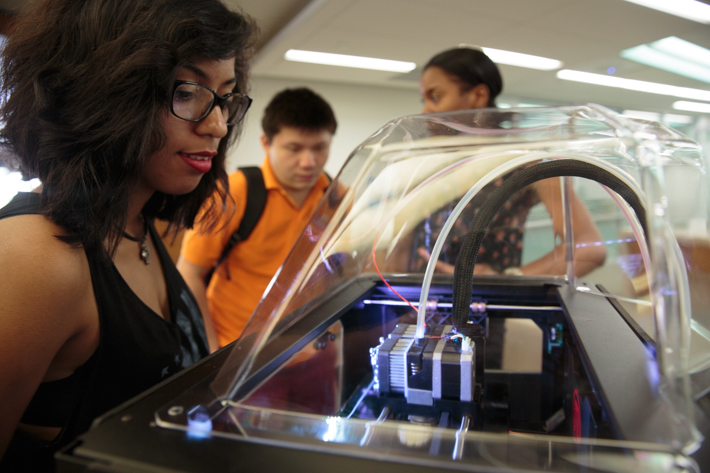George Washington University students, faculty and staff members can tap into their creative side with the GW Libraries’ new MakerBot 3-D printer product suite.
The 21st-century technology housed at the Estelle and Melvin Gelman Library includes a MakerBot Digitizer 3-D scanner and the MakerBot Replicator 2x desktop 3-D printer.
“University libraries locally and across the country are using technology like this to engage students,” said Matt Mihalik, GW Libraries director of information technology. “It’s quickly becoming a common tool of modern libraries.”
The digitizer uses a miniature camera and two lasers to photograph and scan an object from multiple angles and create a digital design file within 12 minutes. The replicator then receives and reads that file and turns the digital model into a 3-D object up to 9.7 inches long, 6 inches wide and 6 inches high.
To create a 3-D object, a plastic thread-like material called ABS is loaded onto a spindle, fed through a tube and heated. The heated filament is then layered successively to build the object using the “Smart Extruder,” which acts as the machine’s hand.
The simple but revolutionary process works similarly to a glue gun, according to Mr. Mihalik.
“The applications are endless for a tool like this at a university—from building models for research projects in humanities courses to creating medical and engineering prototypes or developing a basic widget to solve a problem,” Mr. Mihalik said. “Our priority is that this will first and foremost be a service to students.”
GW Libraries staff purchased the equipment following feedback from students and faculty during the spring 2015 semester. A survey reported that undergraduate and graduate students across all disciplines are interested in using a 3-D printer to enhance their coursework.
Faculty members, such as Jeffrey Cohen, director of the Institute for Medieval and Early Modern Studies, also believe that a 3-D printer supports learning. Dr. Cohen said that students in his spring 2015 medieval literature class would have benefited from having a 3-D printer on hand for their “Life of an Object” project.
“Students look at a medieval object that is integral to one of the texts we read in the course and build a presentation around it,” Dr. Cohen said. “They often find museum images of rings, daggers, swords, shields, bracelets and other items, but being able to recreate such an item via a 3-D printer will really give the object more heft, more life.
“It is one thing to visualize an object, quite another to be able to hold a 3-D version of it,” he said.
To help students and faculty get acquainted with the technology, library staff members performed 3-D printing demonstrations during Welcome Week. Interested students also can attend a workshop on 3-D modeling and using the printer in the coming weeks, according to an announcement from the GW Libraries. Workshops are scheduled for Sept. 22, Oct. 12, Oct. 20 and Nov. 11.
During workshops, students will receive an introduction to the MarkerBot software and learn how 3-D printing works, tips on finding 3-D files online and how to submit a job for printing. Final printed projects will be available at the Gelman Library service desk within 72 hours. The portal to submit designs went live Sept. 15.
Costs for printing will be based on weight of the object, Mr. Mihalik said. And they will be minimal— averaging about 5 cents per gram of ABS.
Though the university previously had two 3-D printers for use on campus, they are exclusive to students and faculty in the School of Engineering and Applied Science and the Columbian College of Arts and Sciences Department of Fine Art and Art History. Expanding access to 3-D printing puts GW Libraries’ technology in line with local colleges and universities such as the University of Maryland.
“The idea is to spark a conversation with the university community about how a 3-D printer can be an asset to the academic experience,” Mr. Mihalik said.
Check out a time-lapse video of the Makerbot Replicator 2x 3-D printer as it builds a miniature bust of university namesake George Washington:
Watch GW Libraries' 3-D Printer In Action from The George Washington University on Vimeo.


